Video
youtube
Nieuwjaarsduik 2018 - een nieuwe start!
Happy new year everyone/gelukkig nieuwjaar allemaal! It’s been a very long time since I have last written a piece about the lovely country where I reside. I’ve had a few changes in my life recently which has caused me to become quite busy, but I haven’t forgotten about this blog! And what better way to restart my activity than with the new year?
Personal quotes aside, what I want to talk about today is a tradition that started back in 1965, which is also known as a “polar bear plunge”. That’s right, I’m talking the Nieuwjaarsduik.
Let’s go back a little first...
Historically, the first ever “polar bear plunge” or “New Year’s Dive” occurred way back in the 1920s in Vancouver, Canada. The term “polar bear plunge” refers to diving into water that is extremely cold, sometimes with chunks of ice in the water. Zo koud! This activity is normally performed on New Year’s Day, hence the “New Year’s Dive”, as many see this as a great way to kick off the new year.
The first Nieuwjaarsduik that occurred in the Netherlands was at Zandvoort in 1960, and has since spread across the country at numerous locations. In 1965, a former canal swimmer from the Hague swimming club Sport Na Arbeid (SNA) (which later merged into Zwemclub Residentie) called Jan van Scheijndel initiated the dive at Scheveningen. At the time, there were only seven participants. This since grew in popularity and, now, the dive at the Scheveningen beach is the most well-known dive with the largest turnout for a New Year’s Dive in the Netherlands. A total of 10.000 people participate in the dive at Scheveningen, and around 50.000 people participate in the dive across the whole of the Netherlands. Heel veel mensen!
2018
Yesterday, my partner and I took part in the 2018 Nieuwjaarsduik on Scheveningen beach. The dive is sponsored by Unox, a Unilever brand that specialises in smoked sausages and soups.
At 10:30 in the morning, you join a fast-moving queue to register yourself to dive. It’s €3 for a ticket, €2 going towards the event and €1 going towards the chosen charity (this year, it was being sent to food banks). You get a goody bag containing the distinctive bright orange bobble hat, a souvenir rosette and a large tin of pea soup. There’s a stage with musical entertainment (lots of dancing!) and two heated tents to warm yourselves up.
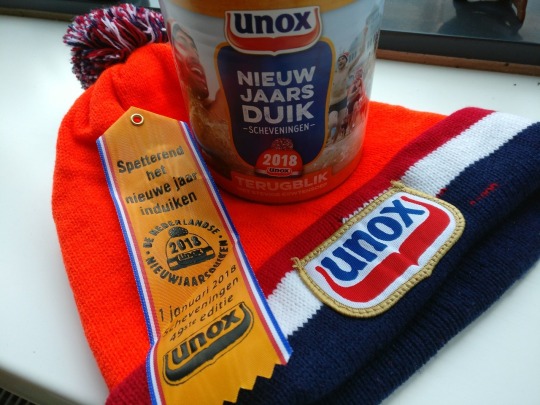
The actual dive occurs at 12:00. When the time is nearing, you strip down to your swimwear and wait by the line. There’s a countdown, and then you make a mad dash to the ice-cold North Sea and dive in!
It was exhilarating. Definitely a great way to welcome the new year (and an effective way to spruce up after a heavy Oud en Nieuw!). It’s something that I highly recommend to anyone who is spending their New Year in the Netherlands.
Reflections
I wrote a blog a year ago about the New Year in the Netherlands here for those who are interested in a little re-cap.I can confidently confirm that the Dutchies are indeed crazy when it comes to fireworks. It’s something to experience! Such fun!
So, I hope this blog has sparked your interest and perhaps inspired you to take part in a New Year’s dive in the future (or to look back fondly on times you have done it before!).
Gelukkig Nieuwjaar! Beste wensen en geluk voor jullie allemaal!
Video source: Unox Nederland, YouTube
#nieuwjaar#happynewyear#newyear#gelukkignieuwjaar#nieuwjaarsduik#newyearsdive#polarbearplunge#cold#ice#water#northsea#netherlands#Nederland#dutch#culture#british#expat#expatlife#holland#unox#peasoup
30 notes
·
View notes
Photo
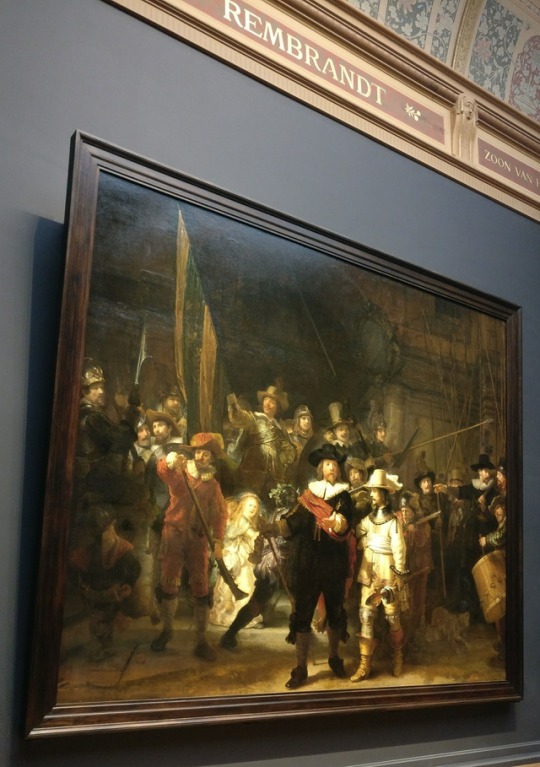
De Nachtwacht/The Night Watch (Rembrandt van Rijn, 1642)
One of the most recognised Dutch Golden Age paintings, the “Militia Company of District II under the Command of Captain Frans Banninck Cocq” or “The Shooting Company of Frans Banning Cocq and Willem van Ruytenburch” (commonly referred to as The Night Watch or De Nachtwacht) by Rembrandt van Rijn is famous for three reasons;
Its enormous size (363 cm × 437 cm or 11.91 ft × 14.34 ft) - the figures depicted in the painting are almost life-size!
Its dramatic use of light and shadow
The perception of motion (paintings of military groups were traditionally portrayed as a static portrait)
The painting shows the schutterij (a voluntary city guard or citizen militia in the medieval and early modern Netherlands) moving out, lead by Captain Frans Banning Cocq (wearing black with a red sash) with his lieutenant, Willem van Ruytenburch (wearing yellow and a white sash). Seventeen members of the kloveniers (civic militia guards) are portrayed in the background. Another character of note is the woman carrying a chicken, who is also highlighted in the painting.
Over the years, the painting has been held in numerous locations across Amsterdam.
Initially, the painting was kept in the Groote Zal (Great Hall) of the Kloveniersdoelen (the musketeers’ shooting range). The Kloveniersdoelen was a complex of buildings that served as the headquarters and shooting range for the local schutterij. The type of arms used was an early type of musket, called the arquebus (in Dutch known as a bus, haakbus or klover).
In 1715, the painting was relocated to the Amsterdam Town Hall, and moved again in 1806 to the Trippenhuis when Napoleon occupied the Netherlands (where the Amsterdam Town Hall became “Palace of the Dam” or “Royal Palace” as it is known today). The Trippenhuis was a mansion to the wealthy Amsterdam weapons traders, Louis and Hendrick Trip, which nowadays houses the Royal Netherlands Academy of Arts and Sciences (or Koninklijke Nederlandse Akademie van Wetenschappen). Napoleon ordered to have the painting returned but, once the occupation ended in 1813, the Trippenhuis held the painting once again.
After just over seven decades, the painting moved to the Rijksmuseum after its complete construction in 1885. Other than for the duration of World War II, when it was stored in Radboud Castle in Medemblik (north of Amsterdam), the painting has remained in its rightful home in the Nachtwachtzaal (Room of the Night Watch) in the Rijskmuseum.
Alterations and nicknames that have stuck!
The beautiful painting we see today has been slightly altered from its original state on two occasions.
One occasion occurred when it was first moved to the Amsterdam Town Hall as mentioned above. The painting was cropped on all four sides to fit its placement between two columns, losing two characters on the left side of the painting, the top of the arch, the balustrade and the edge of the step. A copy of the original composition (by Gerrit Lundens) exists at the National Gallery London, UK.
The other occasion is much more recent. Originally, the Night Watch actually got its name from the dark varnish that was used. This is in fact an incorrect impression of the work, and thus this dark varnish was removed and replaced with a lighter one (highlighting that it was perhaps during the day, as the light shining on the three characters in the painting is sunlight peeking through windows). The name “The Night Watch” still stuck anyway, and is less of a mouthful than its full name!
Definitely worth a see in person
I’ve included the dimensions of the painting in this post, but honestly it is breathtakingly big when you see it in person. The Rijksmuseum is a fantastic museum to visit, certainly a staple for anyone heading to Amsterdam. Not only is the actual museum building attractive in itself, but there is much to see on the inside as well as The Night Watch.
Also, anyone who is keen to have a photo with that infamous “iamsterdam” sign, it is just outside the Rijksmuseum! Gelukkige reizen!
#rijksmuseum#rembrandt#rembrant van rijn#the night watch#de nacht wacht#art#painting#dutch#holland#netherlands#nederlands#nederland#expat#expatlife#expatliving#british#english#travel#city#amsterdam#culture#history
66 notes
·
View notes
Note
It is funny seeing your own culture through someone else's eyes. Why the Netherlands though? I can't quite see the charm myself anymore 😅
Haha! Well, why not? :P The unfamiliar is always exciting for me, and its a bit of a change from my own culture. I moved here and I’m still enjoying it a year later. Hopefully my blog will charm you back!
8 notes
·
View notes
Note
Als Nederlander, wist ik niet eens dat er ook groene en paarse Asperges bestonden!
Als een Brit, wist ik niet dat er witte asperges bestonden! Je leert elke dag iets nieuws. ;)
4 notes
·
View notes
Photo
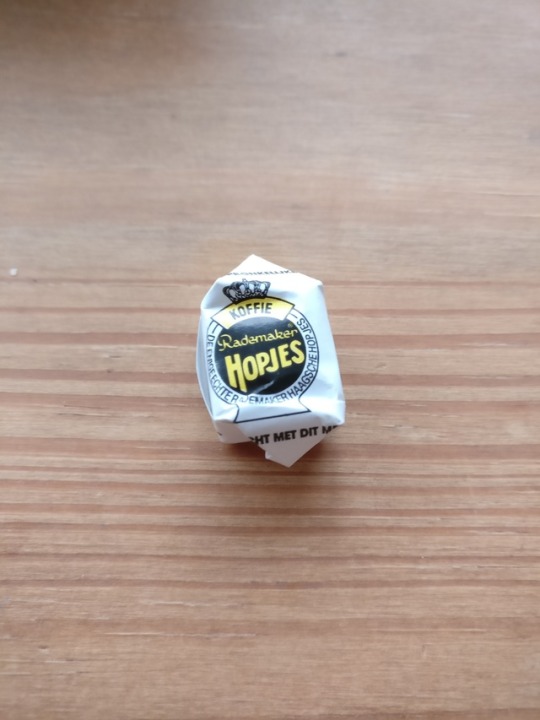
Een beetje smaak van vreugde... een hopje!
These little treats are a type of Dutch sweet that are hard and toffee-like in consistency with caramel and coffee undertones. They are also referred to as Haagse hopjes, or hopjes from the Hague.
For such a small sweet, it has a rather interesting history. An envoy who was in Brussels during the French invasion in 1792 and went by the name of Baron Hendrik Hop is where the story begins. He moved into a room above the confectioners Van Haaren & Nieuwerkerk and was known to have a bit of a coffee addiction. One night, he was brewing his normal coffee with cream on a small stove, but had forgotten about it and left it heating until all of the water had evaporated. He decided to try the remaining substance in the bottom of the pan, and found it delicious! Alsof er een engeltje over je tong piest!
His doctor had told him to stop drinking as much coffee, so he saw fit to request the confectioner who he was living above, Theodorus van Haaren, to make him “lumps of coffee” instead. After some experimenting and tweaking, the sweet we know today was created. Baron Hop was very keen to let his guests try his “hopjes”, and thus their popularity began to grow and grow. Heel lekker.
As for why they are referred to as Haagse hopjes, this all comes from J.P. Rademaker, when he copied the hopjes and marketed them as "the only real Haagse Hopjes". He was the first to cover the sweets in the distinctive wrapper that we see them in today as pictured above which was a strange thing to do at the time with sweets. There were tensions between Rademaker and Nieuwerkerk, even after Rademaker took over Nieuwerkerk in 1949. It wasn’t until a ruling from the Dutch Advertising Code Committee in 1989 (40 years later!) ordered Rademaker to stop from using the phrase “the only real Haagse Hopjes“. Nowadays, Rademaker wrappers use the phrase "Alleen Echt Met Dit Merk" instead, which means "Only Real With This Brand". Drama!
#hopje#hopjes#sweet#sweets#dutch#food#candy#nederlands#Nederland#netherlands#holland#belgium#british#english#expat#expatlife#history#facts#rademaker#baron hendrik hop
23 notes
·
View notes
Note
I just found your blog and I'm so happy! It is so interesting to read because I'm also learning Dutch and it's really great to read information from a tourist's point of view. Thanks for the great content :)
Goedendag @languageswithceles! Veel dank voor jouw vriendelijke woorden!
:) It’s really lovely to hear that you’re reading and finding my blog interesting! Hopefully I’m not a tourist anymore, having lived here for over a year now! But I am happy to give my perspective as a non-Dutchie. :)
Also, thank you for reaching out to me! Your blog is full of some really great and useful stuff. :) I wish you all the best with your Dutch studies, and hope that you reach all your goals. Oefening, oefening, oefening! Heb ik gelijk? :D
Mooie dag en tot ziens!
5 notes
·
View notes
Text
Language tag!
I was tagged by @mots-et-merveilles. Thanks for giving me something a little different for my readers. :)
rules: reblog, tag ten others and share your answers
1. what languages are you studying/have you studied?
I am currently studying Dutch and Thai, and casually dipping into Japanese every so often.
2. how long have you been studying?
I have been intensively studying Dutch for just over a year. This is my main priority. My Japanese has been on and off for about a year.
The story of my Thai studies is a bit more complex as I could speak it confidently when I was very young (my mother’s side of the family is Thai) and it slipped as I grew up and reached adulthood. I’ve never been able to write it. I can still hold small conversations but I have chosen to actually put my head down and study it properly about two months ago.
3. did you learn through class or self study (or both)
I been learning Dutch through both classes and self study (though it is predominantly self study at present). Both Japanese and Thai are through self study.
4. why did you decide to learn this language?
After moving to the Netherlands, I was determined to learn Dutch in order to feel more integrated into the country and its culture. I do not need it for my employment over here right now, but it wouldn’t sit right with me if I didn’t learn how to speak to the locals in their own language rather than just relying on English. I also really enjoy learning it and I like the way it sounds!
In terms of Thai, I want to be able to have more meaningful conversations with my family rather than just small talk. Not all of them speak English, and I want to be able to reach out to more of them.
And as for Japanese, my partner and I were hoping to potentially move there in the future. We visited it recently and absolutely love it there. For this reason, it would be good to get a bit of a head start!
5. what was a major highlight/milestone in studying this language?
With Dutch, it was walking through the city and being able to converse in light conversation with the people around me and in shops! And actually understanding and contributing! Major highlight!
6.what was the hardest thing about learning this language?
As I had said I do not need Dutch (or Thai, or Japanese!) for the likes of my work, so I think that this makes it much harder to practice on a day-to-day basis and keep myself motivated.
7. what resources did you find most useful for studying this language?
Any resource is a good resource. I am a big fan of DuoLingo and utilising YouTube, and generally just finding things that enable you to immerse yourself. If you find music that you like in your target language, or even just watching a film you like in your target language; this all really helps.
8. any top tips for studying this language?
I think this goes for all language learning but don’t lost hope in yourself. There will be certain times that you may find challenging but don’t let that put you off if its what you really want to do. It’s also important to appreciate the culture from which the language comes from, as understanding a culture can help to improve your understanding of the language itself. Try to integrate it into your natural thought process as much as you can. It all comes together. Well, I hope so!
9. what’s your next major language goal?
My next goal is to learn this by heart: https://www.youtube.com/watch?v=1s2EYCsa9n0 I used to know it as a child, so why not as an adult?
10. anything we can do in the tumblr community to get you there?
Just keep reaching out as you do! When you see someone practising in your target language (or even a language you are fully competent in!) don’t be shy to lend a hand or start a conversation. The recipient will truly appreciate your input, I know I always do! :)
If you’ve already been tagged, I apologise! @devouringdutch, @officialbillhader, @juditto, @greysstudies, @taylorgoldsmithshair, @mireille2806sstuff, @somalang, @languageloveaffair, @languagegirl & @talen-en-regendagen
7 notes
·
View notes
Text
Amsterdam Pride - alle kleuren van de regenboog!
Yes! It’s almost that time of year again where Amsterdam hosts probably the largest LGBTQIA (Lesbian, Gay, Bisexual, Transsexual, Queer, Intersex and Asexual) Pride celebration in the world.
It shall commence on Saturday 29th July 2017 and end on Sunday 6th August 2017 (with the infamous Canal Parade taking place on Saturday 5th August).

Let’s have a little history lesson.
Most people are aware that the Netherlands is very well known for its historically progressive approach to LGBT rights. In fact, it is considered to be the most culturally liberal in the world. Recent polls have shown that 90% of the Dutch people support same-sex marriage. Overwhelmingly large for an entire country!
Same-sex activity was first legalised in the Netherlands way back in 1811 after France invaded the country and installed the Napoleonic Code, erasing any remaining sodomy laws and no more were enacted after the country received independence.
Tolerance and awareness towards homosexuality grew and eradicated the consensus that it was considered to be a mental illness in 1973 and banned the law for discrimination of sexual orientation in the military. In 1987, the Homomonument memorial (a large pink granite triangle in the middle of Amsterdam) was erected to "inspire and support lesbians and gays in their struggle against denial, oppression and discrimination" and to pay respect to all of the gay men and lesbians who were tormented in World War II due to their homosexuality. This monument is the first in the world to commemorate gays and lesbians who were killed by the Nazis.
In 1993, the Equal Rights Law was installed where the discrimination of sexual orientation was banned in places of employment, housing, public accommodations, and more. Same-sex Registered Partnerships were legalised in 1998, closely followed by same-sex Marriage in 2001. This includes the right for same-sex joint and step adoption, lesbians may access IVF treatment if desired and transsexuals are allowed to change their legal gender (following diagnosis, but not necessarily with surgery or hormonal treatment).
A bit more about the Pride festival itself.
The first ever Amsterdam Pride was organised in 1996 with a focus on celebrating freedom and diversity, rather than demonstrations of equal rights as with most other Gay Prides. Roze Zaterdag/Pink Saturday is the event (which first occurred in 1977) that relates to the movement for gay rights specifically, rather than a celebration for all. I will talk about that another time!

The full week is chock-a-block with various activities for LGBT supporters, including exhibitions, cultural and sport events. The colourful celebrations happen citywide, with the most anticipated being the Canal Parade which involves heavily decorated boats, floats and musical performances drifting down the main canals for the party-goers to enjoy. Finally, there is a huge closing party on the Sunday on Rembrandtplein.
It’s absolutely worth visiting!
To date, this is probably one of my most favourite festivals I have ever attended in Europe. Last year was my first visit, just after we first moved to the Netherlands in fact, and it’s vibrant and fun, and the atmosphere made it impossible to not just feel excited and happy.
I understand that some people feel perhaps intimidated by an event such as this, and this could be for a whole host of reasons from upbringing to just not being that into a party environment. Let me tell you, not once did I feel like I was forced out of my comfort zone by another. Everyone was truly respectful and open.
It really is just a celebration for diversity and freedom.
So, if you’ve never been and feel like a party, ik beveel het sterk aan!
#gaypride#amsterdampride#pride#lgbt#lgbtqia#lgbtq#lgbtqa#gay#lesbian#transgender#transsexual#sexualorientation#diversity#freedom#dutch#culture#festival#summer#expat#expatlife#expatliving#english#british#nederlands#Nederland#netherlands#holland
123 notes
·
View notes
Photo

Witte asperges? Wat is dit?!
Yes, you heard me correctly. White asparagus. Or you can also refer to them as “white gold” or “queen among vegetables”, als je dat wenst!
From the second Thursday of April until around the end of June, you will see these appearing in the supermarkets, food markets and green grocers around the Netherlands. Let me tell you, they are pretty delicious.
White asparagus actually comes from the same plant that creates the green and purple asparagus but undergo careful gardening under specific growing conditions. So, unlike the coloured variations, the white asparagus is grown underground and covered with a dark sheet in order to maintain the humidity and warmth, and to prevent the colouring stage. They are harvested as soon as the tips start to show above ground.
Due to the extra care that is taken in their growth methods, they are more expensive than the coloured variations. Also, their skin should be peeled prior to cooking and eating as it is thicker than what you would expect with the green and purple asparagus.
There are numerous ways that white asparagus can be served, but traditionally it appears to be an accompaniment to ham, cooked egg, butter and parsley potatoes. Ik heb twee weken geleden witte asperges gekookt, maar in plaats van ham en eieren heb ik kip geroosterd. Erg smakelijk!
If you’re keen to try some, you need to get a crack on because it’s almost the end of the season! But if you do miss it this time, no worries, you can just scrub up on some recipes to get ready for next year!
Photo sourced from DutchNews.nl
#whiteasparagus#white#asparagus#witteasperges#asperges#dutch#food#culture#cuisine#nederlands#Nederland#netherlands
8 notes
·
View notes
Photo
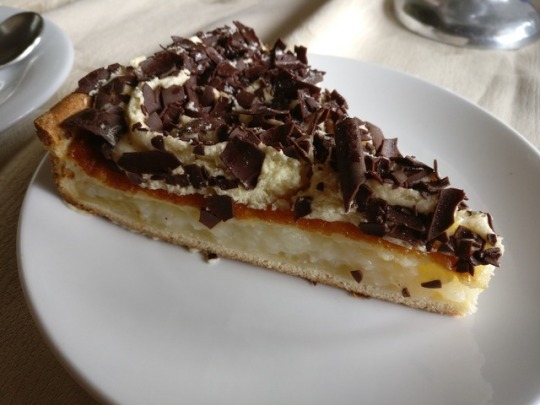
Behold, the rijstevlaai.
It is in the family of the Dutch vlaai, which are pies in the form of a pastry base and a type of filling with no pastry lid. In the case of a rijstevlaai, the filling consists of a type of creamy rice pudding (hence: rijst) baked until the top of the rice pudding filling thickens and forms a soft crust. This is then served cold either as it is or additional toppings are added (as above with the whipped cream and chocolate flakes). Heel lekker met een kopje koffie!
This dish is popular around the Southern-Eastern region of the Netherlands, Eastern Belgium and the German region of Aachen.
#rijstevlaai#rijst#vlaai#pudding#snack#cake#pie#tart#dutch#nederlands#Nederland#netherlands#holland#culture#cuisine#food
38 notes
·
View notes
Text
Vlaggetjesdag...
...or “Flag Day” was held yesterday in Scheveningen, Den Haag (The Hague or s’gravenhage).
This annual May/June event is held to celebrate the year’s first herring catch in the form of a huge street party with numerous music acts, boat races, food stalls and of course... lots of herring! Veel haring!
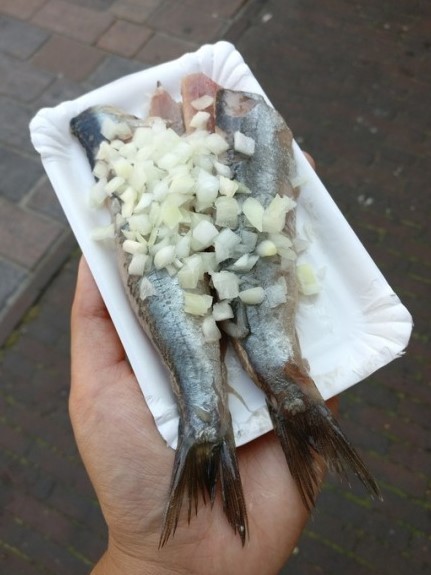
Historically, Vlaggetjesdag was was the day where the fishing boats - totally covered in flags - would be sitting in the port on the Saturday prior to Pentecost (the 49th day after Easter). Following the harsh winters, herring loggers would be the first to set sail in order the test the engines and to re-set the compass for the other boats. In the days following Pentecost, around 15th June, this would be the time when the fishing vessels would catch herring. Following the end of the second world war in 1947, Vlaggetjesdag was officially introduced as the beginning of herring season and to encourage sales of the delicious herring. Heel lekker!
Auction/Veiling
It’s all very exciting. The first barrel of herring is auctioned on the day before the herring is distributed for sales around the country. The money that the herring is sold for goes to charity. This year saw the first barrel of herring go for €65.000 and the money was donated to the Make-A-Wish Foundation. Last year, the first barrel of herring went for €90.000 (for the Stichting Het Vergeten Kind charity)!!
Celebrations and Hollandse Nieuwe
In and around the Scheveningen harbour, there are pop-up stages, there are food stalls, the bars have extended their bars to the streets, there are people in traditional dress, there are old Dutch children’s games... anything for all ages and all interests. Gezellig!
You also have the opportunity to try the fruits of the first herring catch. De Hollandse Niewe. At this time of year, the herring is supposed to be at it’s most delicious and most healthy due to the minimal fat of the herring. I mean, it’s already pretty healthy, as the herring is an extremely lean fish, but it is even more so at the start of the season! I can confirm that the herring is definitely delicious. You can also buy smoked variations to take home!
It’s very multicultural, so if herring isn’t really your thing, there is plenty of different foods and snacks to fill up on. This includes Surinamese, Thai, Indonsian, Italian, Spanish and even British food!
This event is definitely a date for the diary
If you missed it this time round helaas pindakaas!, I highly recommend attending it next year. It’s a fun-packed day with plenty to keep you entertained, and if you want to get away from the crowds you can even just take a gentle stroll down Scheveningen beach with an ice cream!
#flagday#vlaggetjesdag#dutch#nederlands#nederland#netherlands#holland#herring#haring#hollandsenieuwe#event#streetparty#culture
7 notes
·
View notes
Photo
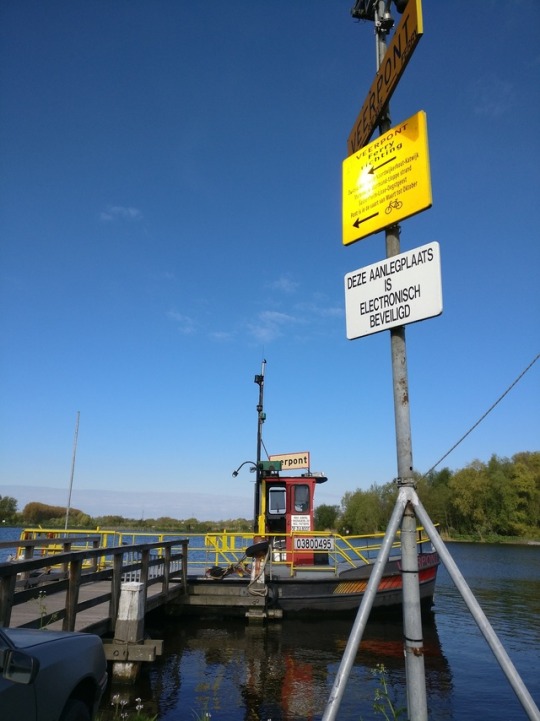
Cycling around the Netherlands is a really nice past time I would highly recommend to anyone. En het is goed voor jouw gezondheid!
It’s incredibly flat, so it’s not too tiring unless you decide to cycle 100km on a city bike like we once did... death. But you can take it at your own pace, and you will come across parts of the Netherlands that you would’t necessarily come by if you’re in a car or train, or even by foot. This includes the infamous tulip fields (if you’re cycling around Lisse or near the Keukenhof), all sorts of wildlife and even strange garden ornaments!
One thing that interested me on a recent cycle was when I was cycling with a friend around a large lake.
The original plan was to cycle the entire circumference of this lake, but then we came across this veerpont or “ferry point”.
Turns out that for a couple of euros, you can take your bike across the lake and join the bike path fietspad at the other side of the lake, without needing to cycle around the whole lake.
As a person who does not come from an area with large lakes, this was very much a novelty to me. There are points like this all around the Netherlands on the larger lakes to make it easier for commuters to get from A to B. Look out for these points during your cycle for a little extra adventure!
7 notes
·
View notes
Text
Het wordt warm... het is bijna zomer!
Any of you who are in the Netherlands right now are probably enjoying the glorious weather. And good news! It’s supposedly getting even hotter this week! So in light of the summery weather, I thought I would share with you some summery Dutch vocabulary to express your delight for the incoming summer months and the summery activities that you may be up to.
zon sun
droog dry
vochtig humid/moist
warm hot
graden degrees
zonnebaden sunbathe
Edit: zonnescherm sunscreen/sun cream sun canopy
looien to tan
bruine lijnen tan lines
zonnebrand sunburn :(
Edit: zonnebrand suncream for sunburn, please check below
zonnebril sunglasses
hoed hat
badkleding swimwear
strand beach
meer lake
zand sand
feest party
zwemmen to swim
surfen to surf
windsurfen to windsurf
volleybal volleyball
tennis tennis
fietsen to bike
Edit: ijs icecream/ice
Edit: ijsje ice lolly
vers fruit fresh fruit
ijsblokjes ice cubes
Edit: Ik fiets naar de het strand. I am biking to the beach.
Edit: Wil je een ijs? Do you want an ice cream?/Do you want some ice?
Edit: Ik kan zien jouw bruine lijnen zien! I can see your tan lines!
Edit: Ze heeft een slechte zonnebrand. She has a bad sunburn.
Hij houdt van volleybal op het strand. He loves volleyball on the beach.
Zij kopen kleurrijke zonnebrillen. They are buying colourful sunglasses.
Het is te warm. Meer ijsblokjes alsjeblift! It is too hot. More ice please!
Edit: Ik ben verbrand I have sunburn/I am burnt.
If there are any mistakes (or if you have any suggestions!) don’t hesitate to get in touch and let me know!
Edit: I have added some corrections to some of the mistakes made!
#dutch#language#language learning#vocabulary#vocabulary list#nederlands#Nederland#netherlands#expat#summer
46 notes
·
View notes
Note
Hi! I saw your post about uitsmijter and it said sth about the dish coming from the german "max strammer" and I just thought maybe you want to know that the term is actually "strammer max" in german
Oops! Thanks for pointing this out to me.Apologies for the mix-up! I shall edit it. :)
1 note
·
View note
Photo

Now this, dames en heren, is a dish called uitsmijter.
Delicious and hits the spot when you’re wanting something warm and filling for lunch. It consists of a slice (or two!) of bread, topped with ham and/or cheese and a minimum of three eggs, fried sunny-side up. There are numerous versions to this dish, including replacing the ham with fried bacon or melting the cheese. Heel lekker.
But wait, it’s called uitsmijter. Isn’t that the Dutch term for a bouncer? As in a bouncer outside of a club or pub?
You are correct! This name possibly was derived from when the dish was first introduced to Amsterdam, where bouncers would make up a large proportion of the people who ordered this meal.
Right, I’ll let you on to a little secret. You’ll see this dish available at most restaurants and bars around the Netherlands but the Dutch did not invent this. The Germans did!
The Dutch uitsmijter is heavily based on the German (Berlin region) dish Strammer Max. Hilariously so, Strammer Max is actually a slang term for an erection... as it’s supposedly good for impotence and infertility. The original Strammer Max dish consists of toasted bread, ham and fried eggs. Geen kaas!
So, when you’re next out and about around the Netherlands, your stomach is grumbling and the clock has struck midday... get yourself an uitsmijter lunch.
Of je kunt het thuis maken! Natuurlijk!
#uitsmijter#max#strammer#lunch#lunchtime#dutch#nederlands#Nederland#holland#netherlands#british#english#expat#expatlife
10 notes
·
View notes
Note
Hoe heb je Nederlands geleerd en waarom heb je eigenlijk naar Nederland verhuisd? Ik weet dat de VK rijk is zoals Nederland dus ja waarom? I also moved to the Netherlands but from Mexico;)
Hallo f-van-lieshout! Bedankt voor jouw vragen. Ik zal in het Engels antwoorden omdat mijn nederlandse nog niet perfect is. :)
So, I started learning Dutch before I moved to the Netherlands using mobile apps like DuoLingo to begin with to help me to become a bit familiar with how the language sounded and the basics of how to structure simple phrases and sentences. Then after I moved, I took some classes (which sadly I had to stop due to work restraints) and decided to try and immerse myself as much as possible. I am not required to speak Dutch for my job, so this can be rather difficult when I am busy! It takes a lot of motivation.
When I have time, I watch children’s programmes and cartoons as I feel the Dutch is simple and has a nice pace for me to grasp. I also take as many opportunities as I can to practice when I am out and about. :) So, this will include little things like asking where something is in a supermarket, or trying to generally converse about the weather when someone is feeling chatty. I know that at the moment my spoken Dutch is rather slow, but I feel this exposure and practice really helps. :)
And as for why I moved to the Netherlands. It was in part due to my partner getting a job out here and also in part wanting to explore a new place to live. My partner and I like to travel a lot when we get the chance, and had spoken about moving to numerous countries together whilst we’re both still young(ish!). The Netherlands isn’t far away from England so it wasn’t too big a transition for our first relocation, but it’s still been really interesting learning about the differences in culture and language.
Dus dat is waarom! Ik hoop dat ik je vragen goed beantwoord heb!
En jij? Waarom ben je naar Nederland verhuisd? Ik ben nog nooit in Mexico geweest, maar op een dag zou ik graag willen bezoeken. :)
Fijne dag en tot ziens. :)
10 notes
·
View notes
Photo
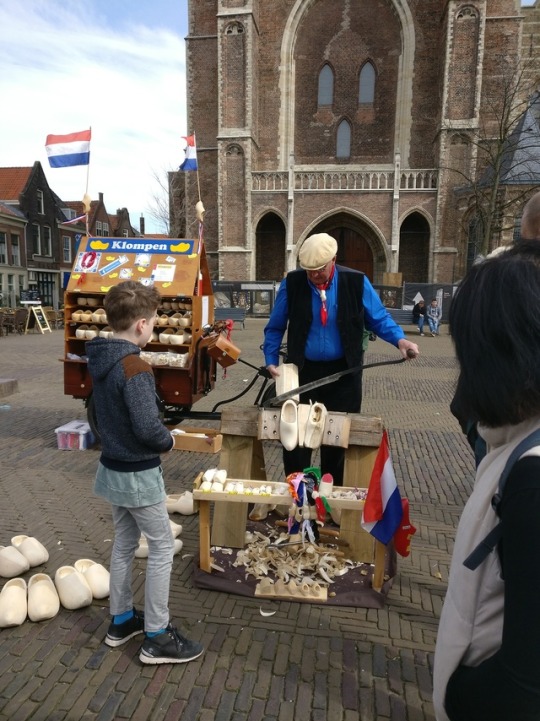
In addition to my klompen post from about a month or so ago, I actually came across a friendly meneer showing us how clogs are actually made.
He had all sorts of different tools, and clogs ranging from teeny tiny (in his scarf!) to much larger ones. It would start with a block of wood (like poplar or something) that he would plane into a general clog shape, bore out the centre and then sand it into the smooth clog we all know and recognise. Ja, met zijn handen!
Additionally, I went somewhere else and came across this brief guide to different types of clog, depending on its intended use. Here we have dike, garden, fisherman and smuggler clogs!
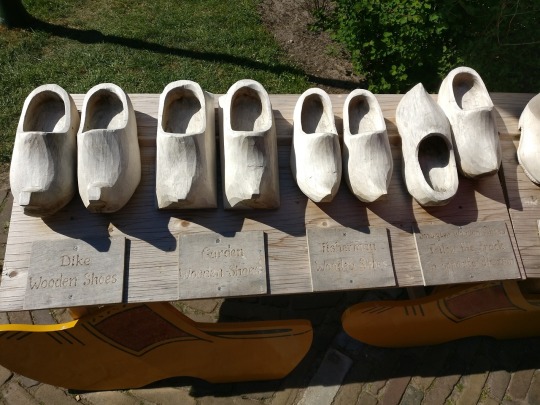
As you can see, they are all slightly different in shape and thickness. The garden clogs are understandably very thick to withstand heavy garden tools, and are also rather square in shape. The fisherman clogs are een beetje thinner, which helps with agility and movement on a boat, whilst maintaining protection of the feet.
If you’re wanting a re-cap on information about klompen, click here.
Dus, waar ben ik in deze foto's? Raad eens!
Ik zal u het antwoord volgende week vertellen!
#clogs#clog shoes#Klompen#dutch#culture#nederlands#Nederland#netherlands#holland#english#british#expatlife#expat#link
54 notes
·
View notes